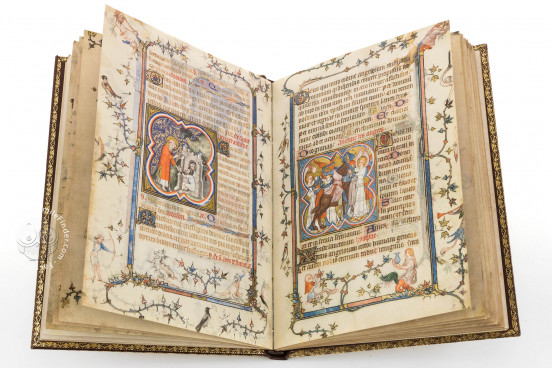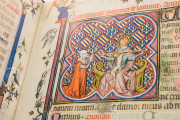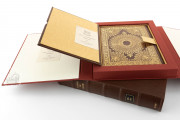The Savoy Hours is one of the most interesting Gothic books of hours from France. The manuscript was written and illuminated in Paris in the second quarter of the 14th century and features 50 beautifully illustrated miniatures of the original 255, as what remains now is only a fragment of a lost masterpiece. The codex is considered extremely significant due to its impact on the figure of Jean, Duke of Berry.
The Atelier of Jean Pucelle and the Grand Scale of the Savoy Hours
The Savoy Hours, written in Latin and French, shows a superb iconographic apparatus which was almost certainly produced in the atelier of Jean Pucelle between the artist’s death in 1334 and the commissioner’s death in 1348; the second part was added at a later time, between 1370 and 1378.
The Savoy Hours was conceived of on a grand scale, both iconographically – with its estimated 187 miniatures and 24 Calendar vignettes – and liturgically.
In terms of iconographic apparatus, the miniatures are framed by tricolor quatrefoils, with the earlier ones set against pink or blue grounds, and the older ones with the grounds in pink or blue imitation relief. The details and intricacy of the decorative scheme, which includes birds and hunters in the margins and bas-de-page, betray the major importance attributed to the decorations within the codex.
From a King's Library to the Fire of Turin
The presence of the arms of Savoy (ff. 2r, 14r, 18v, etc.) and Burgundy (f. 3v) confirms that Blanche of Burgundy (d. 1348), Countess of Savoy and granddaughter of Saint Louis of France, commissioned the work.
The Savoy Hours certainly had an important and royal life, for in the third quarter of the 14th century it became a possession of Charles V, King of France, who asked the Master of the Bible of Jean de Sy, one of the finest artists of his court, to personalize it with additional texts and miniatures. Charles's wife, Jeanne de Bourbon, was represented on one of the destroyed leaves.
The manuscript was later owned by Jean, Duke of Berry, and it has been suggested that it had a great impact on him and on the works he later commissioned, such as the Petites Heures of the Duke of Berry and Les Très Riches Heures of the Duke of Berry.
Unfortunately, the Savoy Hours as we know it is only a fragment of the original manuscript, part of which went lost in a fire in Turin in 1904.
Like many medieval manuscripts, the Savoy Hours no longer features its original binding which was replaced in the 18th century with a red-brown sheepskin binding, heavily gold-tooled with floral borders and corner fans.
We have 1 facsimile edition of the manuscript "Savoy Hours": Savoy Hours facsimile edition, published by Quaternio Verlag Luzern, 2017
Request Info / Price
















